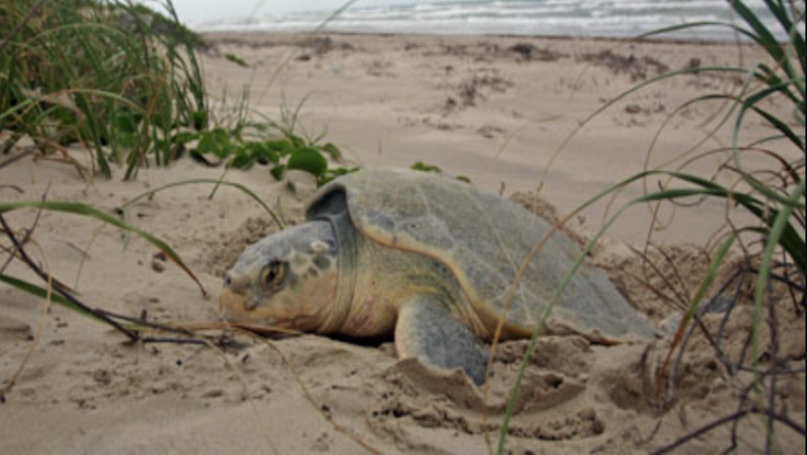
Photos for Headline Surfer / A sea turtle lays eggs on the beach in Daytona in this undated Volusia County image. Below: Ryan Chabot, Volusia County's sea turtle Habitat Conservation Plan program manager, is shown.
By SERA KING / Headline Surfer
DAYTONA BEACH, Fla. -- Turtle nesting season has begun, which means hundreds of sea turtles will be emerging from the surf to lay eggs on the beach in the next few months along Volusia County's shoreline.
The season unofficially started April 10, when the first leatherback nest was discovered in Daytona Beach. Since then, three more nests and one false crawl have been counted between Ormond Beach and New Smyrna Beach.
The turtle nesting season officially began May 1.
After incubating in the sand for about two months, tiny hatchlings will break free and make an often treacherous crawl to the ocean, dodging predators, holes, trash and beach furniture. Tragically, some will also be led into harm’s way by beachfront lighting.
It’s estimated that only about one in 1,000 to 10,000 hatchlings will make it safely to sexual maturity.
Ryan Chabot, Volusia County's sea turtle Habitat Conservation Plan program manager, wants to improve those odds, and he could use the public’s help.
“We want to make Volusia County beaches safe, inviting places for humans and sea turtles,” Chabot said. “We encourage residents and visitors alike to respect our wildlife; let the night provide the light; and keep our beaches clean, dark and flat.”
Artificial lighting is a human-made threat that can be corrected with minimal effort,” Chabot noted. “Bright lights can discourage females from nesting and confuse hatchlings, leading them away from the ocean and into streets or storm drains. By simply redirecting lights away from the beach and turning them off when not in use, beachfront residents can allow natural moonlight and starlight to guide nesting females and hatchlings and keep them out of danger.”
“We want to make Volusia County beaches safe, inviting places for humans and sea turtles,” Chabot said. “We encourage residents and visitors alike to respect our wildlife; let the night provide the light; and keep our beaches clean, dark and flat.”
Artificial lighting is a human-made threat than can be corrected with minimal effort,” Chabot noted.
“Bright lights can discourage females from nesting and confuse hatchlings, leading them away from the ocean and into streets or storm drains. By simply redirecting lights away from the beach and turning them off when not in use, beachfront residents can allow natural moonlight and starlight to guide nesting females and hatchlings and keep them out of danger.”
The county’s Environmental Management Division works with beachfront property owners throughout the year, educating them about the sea turtle lighting ordinance. During nesting season, residents are required to turn off, shield or redirect lights so they don’t shine on the beach.
Residents and visitors can also help save sea turtle lives by following these tips on the beach:
• Do not touch or disturb sea turtles or their nests. It’s. important that hatchlings make their own way to the ocean.
• Do not disturb the dune system or plants. Use designated beach access points and do not walk on the dunes.
• When driving at the beach, use the designated traffic lanes and parking areas. Beach driving access hours are from 8 a.m. to 7 p.m. throughout the nesting season, tide permitting.
• Do not use flash photography at night.
• Do not use cellphones to light your way at night.
• Use only red LED flashlights; they are less visible to turtles.
• After a day at the beach, flatten sandcastles, fill in holes, and take your chairs and equipment with you. This is an easy way to reduce obstacles faced by sea turtles.
• Dispose of trash and recyclables in proper receptacles. Trash left on the beach can attract predators.
• Do not use fireworks. They are not only prohibited on the beach at all times, but they can be disruptive to turtles.
• If you see a nesting adult sea turtle or hatchlings making their way to the ocean, admire them from a safe distance. Stand far away, remain calm and quietly enjoy this special experience. If a turtle appears to be in immediate danger, notify a lifeguard or Beach Safety officer or call the Florida Fish and Wildlife Conservation Commission at 1-888-404-3922.
Fast Facts:
Nesting season runs through Oct. 31. During a typical year, 400 to 500 nests are laid in Volusia County. Last year’s season set a new record with 984 nests counted.
Contact Info:
For more information about Volusia County’s sea turtle program, please call 386-238-4668 or visit www.volusiaseaturtles.org. For questions about sea turtle-friendly lighting, please call 386-238-4773.
 About the Byline Writer:
About the Byline Writer:
Sera King is associate publisher of Headline Surfer, the award-winning 24/7 internet news outlet serving greater Daytona Beach, Sanford, and Orlando, FL via HeadlineSurfer.com since 2008. King also is a byline writer, videographer and cartoonist for the media outlet. King received her bachelor's degree in Business Administration (3.84 gpa) from Ana G. Mendez University in Orlando in 2008.
Headline Surfer LLC is published by Henry Frederick, Central Florida's award-winning journalist.
